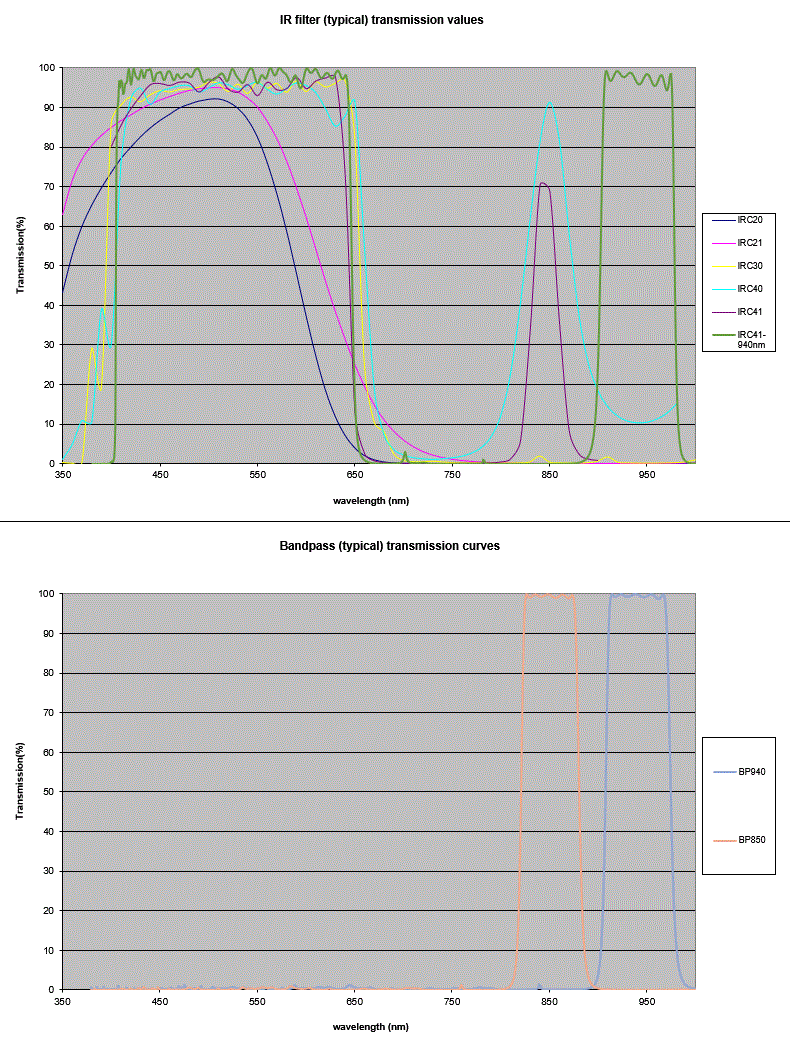Bad pixel includes both dead pixel and warm pixel.
Very easy understanding of dead pixel. And the dead pixel comprise hot pixel and dark pixel. The dark pixel that lasting dark, and hot pixel that lasting bright.
The warm pixel will be influenced by the environment, but its light or dark degree is relatively different, it is possible to be a bit brighter or a bit darker.
For example, the luminance is 200 on average around the warm pixel. That warm pixel is 220 or 180 probably.
Thursday, October 04, 2007
Thursday, June 07, 2007
Purpose of IR Filter in Color Cameras
An IR filter – or IR cut filter - is a color filter blocking the infrared light. There are several good reasons for using an IR-cut filter. Using a color camera to achieve realistic colors in white light requires an IR-cut filter. The color spectrum seen by the human eye is quite limited compared to the spectrum seen by a CCD camera. Especially, in the near infrared region of the spectrum the difference in sensitivity is significant. This is important to know since many light sources, including the sun, emit infrared light. A CCD color camera in daylight without an IR-cut filter will therefore see a significant amount of infrared light resulting in strange colors. Another reason for using an IR-cut filter is the limited color correction for many lenses. It is difficult to design imaging optics covering both the visible spectrum and the near infrared spectrum at the same time. Therefore, many lenses have different depth of focus for the visible and the infrared spectrum. Anyway, the IR-cut filter cuts away a significant amount of the overall collected light and thereby affects the sensitivity in a negative way. In general, color cameras are one factor less sensitive compared to monochrome (depending on the CCD chip). This is primarily due to the IR-cut filter.
Infrared (IR) cut-off filters are used with color CCD or CMOS imagers to produce color images. An IR cut-off filter blocks the transmission of the infrared while passing the visible. This can be done with two optical techniques: absorption or reflection. Absorptive filters are made with special optical glass that absorbs near infrared radiation. Reflection type filters are short-pass interference filters that reflect infrared light with high efficiency.
其常見材質約有下列幾項:
1.遠紫外光學石英玻璃
它是用高純度氫氧熔化的光學石英玻璃。具有優良的 透紫外性能,特別是在短波紫外區,其透過性能遠遠地勝過所有其他玻璃,在185mμ處的透過率可達90%,是185─2500mμ波段范圍內的優良光學材料。
2.紫外光學石英玻璃
它是用氫氧熔化的光學石英玻璃。它是透過220─2500mμ波段范圍內的良好材料。
3.紅外石英玻璃
它是具有較高的透紅外性能,透過率高達85%以上,其應用波段范圍260─3500mμ的光學材料。
IR Cut 的光譜示意圖:
No IR-cut & IR-cut示意圖: Reference:
Reference:
1.http://www.cs.unc.edu/Research/stc/FAQs/Cameras_Lenses/IR%20Filter.htm
2.http://www.optics-online.com/irc.asp
3.http://www.apisc.com/opticaglasses_1.htm
Infrared (IR) cut-off filters are used with color CCD or CMOS imagers to produce color images. An IR cut-off filter blocks the transmission of the infrared while passing the visible. This can be done with two optical techniques: absorption or reflection. Absorptive filters are made with special optical glass that absorbs near infrared radiation. Reflection type filters are short-pass interference filters that reflect infrared light with high efficiency.
其常見材質約有下列幾項:
1.遠紫外光學石英玻璃
它是用高純度氫氧熔化的光學石英玻璃。具有優良的 透紫外性能,特別是在短波紫外區,其透過性能遠遠地勝過所有其他玻璃,在185mμ處的透過率可達90%,是185─2500mμ波段范圍內的優良光學材料。
2.紫外光學石英玻璃
它是用氫氧熔化的光學石英玻璃。它是透過220─2500mμ波段范圍內的良好材料。
3.紅外石英玻璃
它是具有較高的透紅外性能,透過率高達85%以上,其應用波段范圍260─3500mμ的光學材料。
IR Cut 的光譜示意圖:

No IR-cut & IR-cut示意圖:
 Reference:
Reference:1.http://www.cs.unc.edu/Research/stc/FAQs/Cameras_Lenses/IR%20Filter.htm
2.http://www.optics-online.com/irc.asp
3.http://www.apisc.com/opticaglasses_1.htm
Subscribe to:
Posts (Atom)


